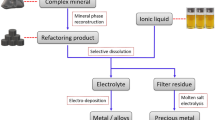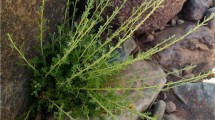Abstract
Microbiologically influenced corrosion (MIC) is one of the reasons leading to the service failure of pipelines buried in the soil. In this work, the effect of sulfate-reducing bacteria (SRB) on the corrosion behavior of Q235 carbon steel in groundwater was investigated by electrochemical methods, surface analysis, and biological analysis. The results show that SRB utilizes iron as electron donor to sustain the vital activities of organic carbon-starved groundwater during the 14-day experimental period. The microbial community composition analysis at the genus level demonstrate that the diversity and richness decrease after corrosion, and the dominant SRB species has changed from Desulfovibrio to Desulfosporosinus. Moreover, the impedance of the carbon steel in the presence of biofilm was 1 order of magnitude higher than that of other periods in the electrochemical test, indicating that the biofilm and formed ferrous sulfide layer impeded the occurrence of corrosion. Although the 3D topography indicated that the surface of carbon steel was more uneven and pits were increased in the presence of SRB, the average weight loss (0.0396 ± 0.0050 g) was much higher than that without SRB (0.0139 ± 0.0007 g). These results implied that the growth of SRB makes the corrosion process of Q235 carbon steel more complicated.








Similar content being viewed by others
Data availability
All data generated or analyzed during this study are included in this published article.
References
Abdulina D, Kováč J, Iutynska G, Kushkevych I (2020) ATP sulfurylase activity of sulfate-reducing bacteria from various ecotopes. 3 Biotech 2020:10. https://doi.org/10.1007/s13205-019-2041-9
Ai T, He Q, Xu J, Yin F, Li H, Ai H (2019) A conceptual method to simultaneously inhibit methane and hydrogen sulfide production in sewers: the carbon metabolic pathway and microbial community shift. J Environ Manage 246:119–127. https://doi.org/10.1016/j.jenvman.2019.05.111
Al-Sultani KF, Khulief ZT, Hasan AA (2021) Characterization of microbiological influence corrosion for API 5L X46 pipeline by sulphate-reducing bacteria (SRB). Mater Today: Proc 42:2169–2176. https://doi.org/10.1016/j.matpr.2020.12.301
Anguita J, Pizarro G, Vargas IT (2022) Mathematical modelling of microbial corrosion in carbon steel due to early-biofilm formation of sulfate-reducing bacteria via extracellular electron transfer. Bioelectrochemistry 145:108058. https://doi.org/10.1016/j.bioelechem.2022.108058
Chen Y, Torres J, Castaneda H, Ju L (2016) Quantitative comparison of anaerobic pitting patterns and damage risks by chloride versus Desulfovibrio vulgaris using a fast pitting-characterization method. Int Biodeterior Biodegradation 109:119–131. https://doi.org/10.1016/j.ibiod.2016.01.012
Dake X, Yingchao L, Fengmei S, Tingyue G (2013) Laboratory investigation of microbiologically influenced corrosion of C1018 carbon steel by nitrate reducing bacterium Bacillus licheniformis. Corros Sci 77:385–390
Dec W, Mosiałek M, Socha RP, Jaworska-Kik M, Simka W, Michalska J (2016) The effect of sulphate-reducing bacteria biofilm on passivity and development of pitting on 2205 duplex stainless steel. Electrochim Acta 212:225–236. https://doi.org/10.1016/j.electacta.2016.07.043
Dou W, Liu J, Cai W, Wang D, Jia R, Chen S et al (2019) Electrochemical investigation of increased carbon steel corrosion via extracellular electron transfer by a sulfate reducing bacterium under carbon source starvation. Corros Sci 150:258–267. https://doi.org/10.1016/j.corsci.2019.02.005
Duan J, Wu S, Zhang X, Huang G, Du M, Hou B (2008) Corrosion of carbon steel influenced by anaerobic biofilm in natural seawater. Electrochim Acta 54:22–28. https://doi.org/10.1016/j.electacta.2008.04.085
Enning D, Garrelfs J (2014) Corrosion of iron by sulfate-reducing bacteria: new views of an old problem. Appl Environ Microbiol 80:1226–1236. https://doi.org/10.1128/AEM.02848-13
Fan Y, Chen C, Zhang Y, Liu H, Liu H, Liu H (2021) Early corrosion behavior of X80 pipeline steel in a simulated soil solution containing Desulfovibrio desulfuricans. Bioelectrochemistry 141:107880. https://doi.org/10.1016/j.bioelechem.2021.107880
Gu T (2012) New understandings of biocorrosion mechanisms and their classifications. J Microb Biochem Technol 4:4. https://doi.org/10.4172/1948-5948.1000e107
Hamuel JD, Patrick AN, Izanne SH, Spinney B (2011) The ecology, biology and pathogenesis of Acinetobacter spp.: an overview. Microbes Environ 26:101–112
Hsu C, Chen T, Lo K, Lee Y (2019) Inhibitive properties of benzyldimethyldodecylammonium chloride on microbial corrosion of 304 stainless steel in a Desulfovibrio desulfuricans-inoculated medium. Materials (Basel) 12:307. https://doi.org/10.3390/ma12020307
Javed MA, Neil WC, McAdam G, Wade SA (2017) Effect of sulphate-reducing bacteria on the microbiologically influenced corrosion of ten different metals using constant test conditions. Int Biodeterior Biodegradation 125:73–85. https://doi.org/10.1016/j.ibiod.2017.08.011
Javed MA, Stoddart PR, Wade SA (2015) Corrosion of carbon steel by sulphate reducing bacteria: initial attachment and the role of ferrous ions. Corros Sci 93:48–57. https://doi.org/10.1016/j.corsci.2015.01.006
Li FS, An MZ, Duan DX (2011) Effects of sulfate-reducing bacteria on the corrosion of Q235. Adv Mater Res 396:1777–1785. https://doi.org/10.4028/www.scientific.net/AMR.396-398.1777
Liang L, Ren Y, Tian Y, Garci JAA, Zhang P, Zhu X (2023) Role of Pseudomonas fluorescens FSYZ01 on the corrosion behavior of Q235B carbon steel in oilfield produced water. Environ Sci Pollut Res Int 30:62590–62601. https://doi.org/10.1007/s11356-023-26446-y
Liduino VS, Leoni GB, Servulo EFC, Cammarota MC (2023) Investigation of carbon steel corrosion by oilfield nitrate- and sulfate-reducing prokaryotes consortia in a hypersaline environment. Environ Sci Pollut Res Int 30:10830–10840. https://doi.org/10.1007/s11356-022-22896-y
Liu T, Guo Z, Zeng Z, Guo N, Lei Y, Liu T et al (2018) Marine bacteria provide lasting anticorrosion activity for steel via biofilm-induced mineralization. ACS Appl Mater Interfaces 10:40317–40327. https://doi.org/10.1021/acsami.8b14991
Loubinoux J, Valente FMA, Pereira IAC, Costa A, Grimont PAD, Le Faou AE (2002) Reclassification of the only species of the genus Desulfomonas, Desulfomonas pigra, as Desulfovibrio piger comb. nov. Int J Syst Evol Microbiol 52(4):1305–1308
Madirisha M, Hack R, van der Meer F (2022) Simulated microbial corrosion in oil, gas and non-volcanic geothermal energy installations: the role of biofilm on pipeline corrosion. Energy Rep 8:2964–2975. https://doi.org/10.1016/j.egyr.2022.01.221
McBeth JM, Emerson D (2016) In situ microbial community succession on mild steel in estuarine and marine environments: exploring the role of iron-oxidizing bacteria. Front Microbiol 7:767. https://doi.org/10.3389/fmicb.2016.00767
Mogensen GL, Kjeldsen KU, Ingvorsen K (2005) Desulfovibrio aerotolerans sp. nov., an oxygen tolerant sulphate-reducing bacterium isolated from activated sludge. Anaerobe 11:339–349. https://doi.org/10.1016/j.anaerobe.2005.04.002
Moradi M, Ghiara G, Spotorno R, Xu D, Cristiani P (2022) Understanding biofilm impact on electrochemical impedance spectroscopy analyses in microbial corrosion and microbial corrosion inhibition phenomena. Electrochim Acta 426:140803. https://doi.org/10.1016/j.electacta.2022.140803
Pal MK, Lavanya M (2022) Microbial influenced corrosion: understanding bioadhesion and biofilm formation. J Bio Tribocorros 8(3):76. https://doi.org/10.1007/s40735-022-00677-x
Pester M, Brambilla E, Alazard D, Rattei T, Weinmaier T, Han J et al (2012) Complete genome sequences of Desulfosporosinus orientis DSM765T, Desulfosporosinus youngiae DSM17734T, Desulfosporosinus meridiei DSM13257T, and Desulfosporosinus acidiphilus DSM22704T. J Bacteriol 194:6300–6301. https://doi.org/10.1128/JB.01392-12
Rao TS, Feser R (2023) Biofilm formation by sulphate-reducing bacteria on different metals and their prospective role in titanium corrosion. Environ Technol:1–14. https://doi.org/10.1080/09593330.2023.2178976
Robertson WJ, Bowman JP, Franzmann PD, Mee BJ (2001) Desulfosporosinus meridiei sp. nov., a spore-forming sulfate-reducing bacterium isolated from gasolene-contaminated groundwater. Int J Syst Evol Microbiol 51:133. https://doi.org/10.1099/00207713-51-1-133
Sajadi GS, Saheb V, Shahidi-Zandi M, Hosseini SMA (2022) A study on synergistic effect of chloride and sulfate ions on copper corrosion by using electrochemical noise in asymmetric cells. Sci Rep 12(1):14384. https://doi.org/10.1038/s41598-022-18317-2
Shi L, Dong H, Reguera G, Beyenal H, Lu A, Liu J et al (2016) Extracellular electron transfer mechanisms between microorganisms and minerals. Nat Rev Microbiol 14:651–662. https://doi.org/10.1038/nrmicro.2016.93
Song Y, Chetty K, Garbe U, Wei J, Bu H, O'Moore L et al (2021) A novel granular sludge-based and highly corrosion-resistant bio-concrete in sewers. Sci Total Environ 791:148270. https://doi.org/10.1016/j.scitotenv.2021.148270
Stanley W, Southam G (2018) The effect of gram-positive (Desulfosporosinus orientis) and gram-negative (Desulfovibrio desulfuricans) sulfate-reducing bacteria on iron sulfide mineral precipitation. Can J Microbiol 64(9):629–637
Tripathi AK, Thakur P, Saxena P, Rauniyar S, Gopalakrishnan V, Singh RN et al (2021) Gene sets and mechanisms of sulfate-reducing bacteria biofilm formation and quorum sensing with impact on corrosion. Front Microbiol 12:754140. https://doi.org/10.3389/fmicb.2021.754140
Venzlaff H, Enning D, Srinivasan J, Mayrhofer KJJ, Hassel AW, Widdel F et al (2013) Accelerated cathodic reaction in microbial corrosion of iron due to direct electron uptake by sulfate-reducing bacteria. Corros Sci 66:88–96. https://doi.org/10.1016/j.corsci.2012.09.006
Wang Z, Li Y, Ren J, Xu W, Yang L (2022) Investigating the effects of environment, corrosion degree, and distribution of corrosive microbial communities on service-life of refined oil pipelines. Environ Sci Pollut Res Int 29:52204–52219. https://doi.org/10.1007/s11356-022-19556-6
Wen J, Zhao K, Gu T, Raad II (2009) A green biocide enhancer for the treatment of sulfate-reducing bacteria (SRB) biofilms on carbon steel surfaces using glutaraldehyde. Int Biodeterior Biodegradation 63:1102–1106. https://doi.org/10.1016/j.ibiod.2009.09.007
Xu D, Gu T (2014) Carbon source starvation triggered more aggressive corrosion against carbon steel by the Desulfovibrio vulgaris biofilm. Int Biodeterior Biodegradation 91:74–81. https://doi.org/10.1016/j.ibiod.2014.03.014
Xu J, Sun C, Yan M, Wang F (2013) Variations of microenvironments with and without SRB for steel Q235 under a simulated disbonded coating. Ind Eng Chem Res 52:12838–12845. https://doi.org/10.1021/ie303335n
Yang J, Wang ZB, Qiao YX, Zheng YG (2022) Synergistic effects of deposits and sulfate reducing bacteria on the corrosion of carbon steel. Corros Sci 199:110210. https://doi.org/10.1016/j.corsci.2022.110210
Yingchao L, Siqiao F, Huamin L, Xiankai T, Yeyin X, Mu L et al (2020) Bacterial distribution in SRB biofilm affects MIC pitting of carbon steel studied using FIB-SEM. Corros Sci 167:108512
Zhang P, Xu D, Li Y, Yang K, Gu T (2015) Electron mediators accelerate the microbiologically influenced corrosion of 304 stainless steel by the Desulfovibrio vulgaris biofilm. Bioelectrochemistry 101:14–21. https://doi.org/10.1016/j.bioelechem.2014.06.010
Funding
This work was financially supported by the Project of Shandong Province Higher Educational Young Innovative Talent Introduction and Cultivation Team (Wastewater Treatment and Resource Innovation Team).
Author information
Authors and Affiliations
Contributions
Wenxin Hua: writing — original draft; methodology; writing — review and editing. Rui Sun: data curation, writing — original draft. Xiaoyan Wang: investigation. Yunyun Zhang: software. Jiaxing Li: formal analysis. Ri Qiu: visualization, supervision. Yu Gao: validation, resources, project administration, supervision. All authors read and approved the final manuscript.
Corresponding author
Ethics declarations
Ethics approval and consent to participate
Not applicable.
Consent for publication
All the authors approved the manuscript.
Competing interests
The authors declare no competing interests.
Additional information
Responsible Editor: Diane Purchase
Publisher’s Note
Springer Nature remains neutral with regard to jurisdictional claims in published maps and institutional affiliations.
Rights and permissions
Springer Nature or its licensor (e.g. a society or other partner) holds exclusive rights to this article under a publishing agreement with the author(s) or other rightsholder(s); author self-archiving of the accepted manuscript version of this article is solely governed by the terms of such publishing agreement and applicable law.
About this article
Cite this article
Hua, ., Sun, R., Wang, X. et al. Corrosion of Q235 carbon steel induced by sulfate-reducing bacteria in groundwater: corrosion behavior, corrosion product, and microbial community structure. Environ Sci Pollut Res 31, 4269–4279 (2024). https://doi.org/10.1007/s11356-023-31422-7
Received:
Accepted:
Published:
Issue Date:
DOI: https://doi.org/10.1007/s11356-023-31422-7




